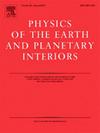A two-and-a-half-dimensional flexing-drip model of lithospheric instabilities and proto-subduction (with two-phase grain-damage)
IF 1.9
3区 地球科学
Q2 GEOCHEMISTRY & GEOPHYSICS
引用次数: 0
Abstract
The emergence of plate tectonics on the early Earth likely first requires subduction to initiate motion and to harness the mantle's convective gravitational energy as a power source. Whether such proto-subduction initiated as lithospheric drips (Rayleigh-Taylor like instabilities), or was triggered by mantle plumes (or even bolide impacts) remains a mystery. To infer whether drip instabilities and intermittent downwellings are possible causes of subduction initiation, we have developed a relatively simple two-and-a-half-dimensional (2.5-D) model of lithospheric instabilities. We specifically use this model to examine whether such instabilities, coupled to shear-localizing mechanisms like two-phase grain damage, can lead to subduction-like features, as well as semi-permanent weak zones that can be reactivated later to make new plate boundaries. Our model couples the physics of drip instabilities of amplitude in a horizontal 2-D layer with 2-D viscous lithospheric flexure (bending and folding) of amplitude . The flexure model is generalized from the Biot's classical 1-D thin-plate theory by accounting for all bending and twisting torques, as well as complex rheology. The drip and flexure models are coupled in that the drips act as a load on the bending lithosphere, while vertical flexure affects the heat transport and pressure gradients governing drip growth. The coupled model predicts least stable mode selection of drip and flexure instabilities, in some cases bimodal instabilities wherein one mode is oscillatory, thus predicting intermittent downwellings. With two-phase grain damage, drips localize into narrow features, often organizing into strings of drips, which induce lineated or arcuate weak zones suggestive of dormant and inheritable plate boundaries.
岩石圈不稳定性和原俯冲(含两相颗粒损伤)的二维半弯曲-滴流模型
早期地球板块构造的出现可能首先需要俯冲来启动运动,并利用地幔的对流重力能量作为动力来源。这种原始俯冲是由岩石圈滴流(瑞利-泰勒式的不稳定性)引发的,还是由地幔柱(甚至是火流星撞击)引发的,仍然是一个谜。为了推断滴水不稳定性和间歇性下沉是否是俯冲起始的可能原因,我们开发了一个相对简单的2.5维岩石圈不稳定性模型。我们特别使用这个模型来研究这种不稳定性,加上剪切局部机制,如两相颗粒损伤,是否会导致类似俯冲的特征,以及半永久性的薄弱带,这些薄弱带可以在以后重新激活以形成新的板块边界。我们的模型将水平二维层中振幅为h的水滴不稳定性与振幅为w的二维粘性岩石圈挠曲(弯曲和折叠)耦合在一起。挠曲模型是由Biot经典的一维薄板理论推广而来,考虑了所有的弯曲和扭转力矩以及复杂的流变学。液滴和弯曲模型是耦合的,液滴在弯曲的岩石圈上起载荷作用,而垂直弯曲影响控制液滴生长的热传递和压力梯度。耦合模型预测滴流和弯曲不稳定的最不稳定模式选择,在某些情况下双峰不稳定,其中一个模式是振荡的,因此预测间歇性下降。随着两相颗粒的破坏,液滴局部化为狭窄的特征,经常组织成串状的液滴,形成线状或弓形的弱带,暗示着休眠和可继承的板块边界。
本文章由计算机程序翻译,如有差异,请以英文原文为准。
求助全文
约1分钟内获得全文
求助全文
来源期刊

Physics of the Earth and Planetary Interiors
地学天文-地球化学与地球物理
CiteScore
5.00
自引率
4.30%
发文量
78
审稿时长
18.5 weeks
期刊介绍:
Launched in 1968 to fill the need for an international journal in the field of planetary physics, geodesy and geophysics, Physics of the Earth and Planetary Interiors has now grown to become important reading matter for all geophysicists. It is the only journal to be entirely devoted to the physical and chemical processes of planetary interiors.
Original research papers, review articles, short communications and book reviews are all published on a regular basis; and from time to time special issues of the journal are devoted to the publication of the proceedings of symposia and congresses which the editors feel will be of particular interest to the reader.
 求助内容:
求助内容: 应助结果提醒方式:
应助结果提醒方式:


